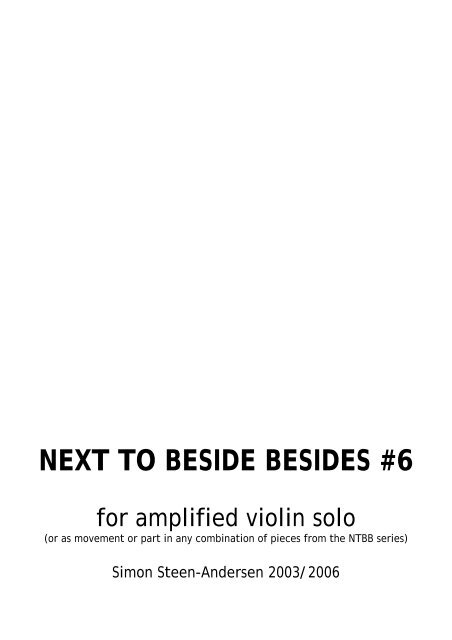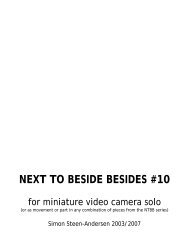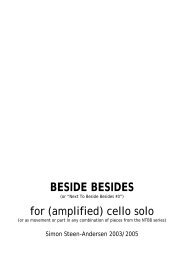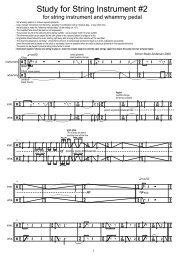NEXT TO BESIDE BESIDES #6 - Simon Steen-Andersen
NEXT TO BESIDE BESIDES #6 - Simon Steen-Andersen
NEXT TO BESIDE BESIDES #6 - Simon Steen-Andersen
Create successful ePaper yourself
Turn your PDF publications into a flip-book with our unique Google optimized e-Paper software.
<strong>NEXT</strong> <strong>TO</strong> <strong>BESIDE</strong> <strong>BESIDE</strong>S <strong>#6</strong>for amplified violin solo(or as movement or part in any combination of pieces from the NTBB series)<strong>Simon</strong> <strong>Steen</strong>-<strong>Andersen</strong> 2003/2006
Scordatura:3rd string down ¾ of a tone, 4 th string down a major 3 rd :(The music is notated where it should be played – not as it sounds.)Preparation:Place a “crocodile clamp” at the highest point of the fret board onthe 1st string, so that it vibrates against the wood when played:Mute:The piece should be played with a metal practice mute.Amplification:The violin should be amplified as much as possible without it being unpleasant – at least loud enough to give afeeling of zooming in on the very soft sounds.When played together with other versions of NTBB the amplification should level out the dynamic differencesbetween the instruments as much as possible.Dynamics:Action dynamics are written in parenthesis (fff) and indicate the amount of energy to be put into an actioneven though the resulting sound is much softer. The ppp (without parenthesis) should be the softest possibleeven dynamic (trying to match all the soft events).Crescendos and diminuendos should be performed “exponentially” (very late cresc. with much direction, etc.).When ending or starting in an accentuated point, the point should always be a bit louder than the crescendedor diminuended sound, in order to make them “melt together”, like a zoom (reverse reverb) or “natural”reverb of the accentuated point.In general:The piece should be played as “dry” as possible, not letting open strings or harmonics ring out.Signs and abbreviations:Bowing on the body of the instrument. If the sign is above the system it indicates the body onthe treble side of the instrument – below the system indicates the bass side of the instrument.When going legato from string to body, use the same tilting technique as when changing backand forth between two strings in one bow.Simultaneous glissando and arpeggio (or in general: changing string within a glissando). Thefirst cord indicates the relative finger positions. The large note is the first one to be playedand then changing string in the indicated rhythm while performing the indicated glissando.Gradual transition from pure tone to pure noise (no recognisable pitch).Hit/tap indicated string(s) with left hand for percussive sound(without letting the open strings sound).‘Press’ or tap the indicated string at the position the small note head.s.a. Senza arcoc.l.b. Col legno battuto (while damping string).+ Left hand pizzicato.No ledger lines means approximate precision.Tremolo is always unmeasured and to be performed as dense as possible.Staccato is always as short as possible (no matter the length of the note).
Next To Beside Besides – en “re-cyklus”Et abstrakt konciperet musikstykke vil stadig være det samme stykke, selvom det spilles på instrumentermed grundlæggende forskellige typer af bevægelser. Men hvad hvis den abstrakte komposition rettede sigimod bevægelserne? Hvad hvis kompositionen blev set som en koreografi for musiker og instrument – medlyd til følge? Så ville det samme stykke lyde vidt forskelligt på instrumenter med grundlæggende forskelligeforhold mellem bevægelse og lyd. Og ville det så overhovedet være det samme stykke?Re-cyklus’en ”Next To Beside Besides” er en åben serie af koreografiske oversættelser af stykket ”BesideBesides” (for hotel-sordineret solo cello), der allerede i sig selv er et spin-off fra sekstetten ”Besides”.(”Besides” var, ud over betydningen ”desuden...” og ”b-sider”, ment som den ikke-eksisterende flertalsformaf at være-ved-siden-af).”Beside Besides” indeholder elementer på mange forskellige trin af skalaen mellem ren klang og renbevægelse og vil således resultere i oversættelser, der svinger mellem nøjagtigt ensklingende passager(dér, hvor musikken er klangligt eller abstrakt konciperet) og vidt forskelligt klingende passager (dér, hvormusikken fx er baseret på glidende lineære bevægelser i forskellige dimensioner).For at opleve disse grader af forskelle kræves naturligvis, at man hører de forskellige versioner op imodhinanden – det være sig forskudt, eller endnu bedre: simultant! Cyklus’en er således ikke blot en åbenrække af variationer, udgaver eller løsninger på forskellige oversættelsesmæssige problemstillinger ogangrebsvinkler, men giver også mulighed for utallige kombinationer af klangligt heterofone, menbevægelsesmæssigt ”unisone” ensemble-kompositioner, hvor netop forskel og lighed er i fokus, hvor selveoversættelsessituationen bliver et musikalsk parameter.Alle stykker skal kunne spilles alene eller i en hvilken som helst kombination af versioner, samtidigt ellerefter hinanden som satser eller mellem andre stykker som fragmenter.Hvert stykke skal være lige tro mod originalen og dermed være lige idiomatisk og tro mod det pågældendeinstrument!Next To Beside Besides – a “re-cycle”An abstractly conceived piece of music will still be the same piece even though played on instruments withessentially different types of movements. But what if the abstract composition was directed towards themovements? What if the composition was thought of as a choreography for musician and instrument – withsound as a consequence? Then the same piece would sound completely different on instruments withdifferent relations between movement and sound. And would it then be the same piece at all?The re-cycle ”Next To Beside Besides” is an open series of choreographical translations of the piece”Beside Besides” (for solo cello), a piece that already in it self is a spin-off from the ensemble piece”Besides”. (”Besides” was, beside the meaning ”besides...” or ”b-sides”, ”back-sides”, meant as the nonexistingplural of being next to).The many different degrees of abstractness and concreteness between pure sound and pure movement in”Beside Besides” will result in translations that contain exactly equally sounding passages (where the musicis thought abstract or in sound) and very different sounding passages (where the music for example isbased on gradual linear movements in different dimensions).To experience these degrees of differences one has to hear the different versions next to each other – thiscould be one after another, or maybe even better: simultaneously! The cycle is in other words not just anopen row of variations, versions or solutions of different problems and methods of translation – it also givesthe opportunity to put together innumerous of combinations of heterofonically sounding, but movement wise”unison” ensemble compositions, where difference and equality are in focus – where the translationsituation in itself becomes a musical parameter.Every piece can be played alone or in any combination of versions, simultaneously or one after the other asmovements or between other pieces as fragments.Every piece must be equally faithful to the original, which also means being equally idiomatic and faithful tothe instrument in focus!©2006 <strong>Simon</strong> <strong>Steen</strong>-<strong>Andersen</strong> : www.simonsteenandersen.dk / mail@simonsteenandersen.dk
Next To Beside Besides – meet the family!Choreographic Translations for amplified solo instruments or ensembles +Next To Beside Besides is a series of "choreographic translations" (translations of the movements oractions, rather than an instrumentation of the resulting sounds) of the piece Beside Besides for solo cello,which is itself a modification of the ending of the piece Besides for three amplified instruments and threedampened instruments. All translations can be played solo or together in any combination simultaneouslyas ensemble pieces. Solo versions or combinations can be played alone or after each other as movementsor between other pieces in a concert (or on different concerts) as ritornellos. The cycle will continue on theinternet, where studio recordings of the premiered translations can be heard solo or in any combination,later extended with an interactive web-translation, called Above Next To Beside Besides, and more.The FamilyBesides (2003) (18')for amplified piccolo flute, piano with whammy pedal and violin plus dampened string trio.Beside Besides (a.k.a. NTBB #0) (2004) (4')for amplified cello solo.Next To Beside Besides #1-9 +... (2005-2006) (4')for any combination of amplified double bass, saxophone, accordion, percussion, piccolo flute, violin, piano,guitar and a silent version for close-up camera +... (See www.simonsteenandersen.dk for an updated list.)Self-reflecting Next To Beside BesidesTwo or more translations performed by the same player with video; the second translation played togetherwith a video recording of the first, the third translation played together with a video recording of the secondperformed with the video recording of the first, etc. Other instruments can be added - only criteria is that atleast one player should perform live every time together with a video recording of him self performing adifferent translation.For now there is only material for a percussion player to perform combinations of the versions forpercussion, piccolo and camera with video. Several more alternative versions are planned for all strings,guitar and percussion. (See www.simonsteenandersen.dk for an updated list.)Future GenerationsAbove Next To Beside Besides (2007)Interactive web-piece / "Virtual Sinfonietta". Meta-work in the sense that it displays general ideas behind theseries. Interactive in the sense that it’s a web instrument ideal and easy to play a translation of NTBB on –or to improvise on or compose for. Will include various didactic elements as well.Around Next To Beside BesidesTranslation of the movements in Next To Beside Besides to spatially staged sinfonietta. Can be performedby itself as an ensemble piece or with any of the solo-translations in front as a solo concerto or with acombination of solo-translations in front as a concerto grosso. The instruments can change positions/partsand in this way generate various different versions.Behind Self-reflecting Next To Beside BesidesContinuation of a performance of Self-reflecting NTBB into a room-installation (three projections of prerecordedvideo and one live-projection of the spectators watching the installation).
Next To Beside Besides <strong>#6</strong>for violin soloPreparation:- Place "crocodile clamp" on the 1st string at the highest point of the fingerboard as shown in the preface.- Detune 3rd string to a quarter tone raised C (down 3/4 of a tone) and 4th string to Eb (major 3rd).q=60 (pianissimo) furioso& 4 3œo ≤ 3œ œ œ œ œ( fff )(or as movement or part in any combination of pieces from the NTBB series)(bow close to the clamp - as much sound from theclamp vibrating against the wood as possible (legato) -as little scratchy noise from the bow as possible)3333œ œ œ œ œ œ œ œ œ œ œ œ(treble side)–.–.43333œ œ œ œ œ œ œ œ œ œ œ œ& 4 2+œ oppp 5senzaarcobow on bodysenzaarcoO –.– . O –.7& ≈ ‰ .+ O –. –O O. sempre s.a. s.a. s.a.Os.a.œ ‰ ≈ ‰œ+4 6 3œ ≤ 33œ œ œ œ œ œ œ œ4 2555( fff )5(tap 1st string lightly ata point close to theclamp and leave thefinger on the string asif to take a harmonic)œ+–OOO10& 4 2 ≥3OOO œœ> œœ O 5O4 3 œ+ O –. – . + O – . s.a.s.a.œ ≈ 4 2œ– œœœœ+ + Os.a.œ œ+ œ ≤ œ+> œ ≥ .. œ œ œ œœ5:3–( fff ).3 3( fff )ppp 3( f )ppp14& 4 2‰ .bow on body(bass side)5œ+–.ppp≈Os.a.‰‰ .5– . ≈ œ+ ‰O –. ‰ .s.a.5‰ .5– . ≈– – – –Ȯ. 3œ+>‰ ≈ œ ≤ œ œ3> ppp ( fff )s.a.( F )–19œ > – – . O+œ+& ‰ ≈+ œ ‰ + O – (arco)– . – . –œ œ+ œ . ‰ + œ ‰ œ+‰ . 4 3 œ+>‰+ O.s.a. s.a. s.a.œ ‰ ≈ ≈ ≈ 4 1( F )553 3535ppp( F )∏1






